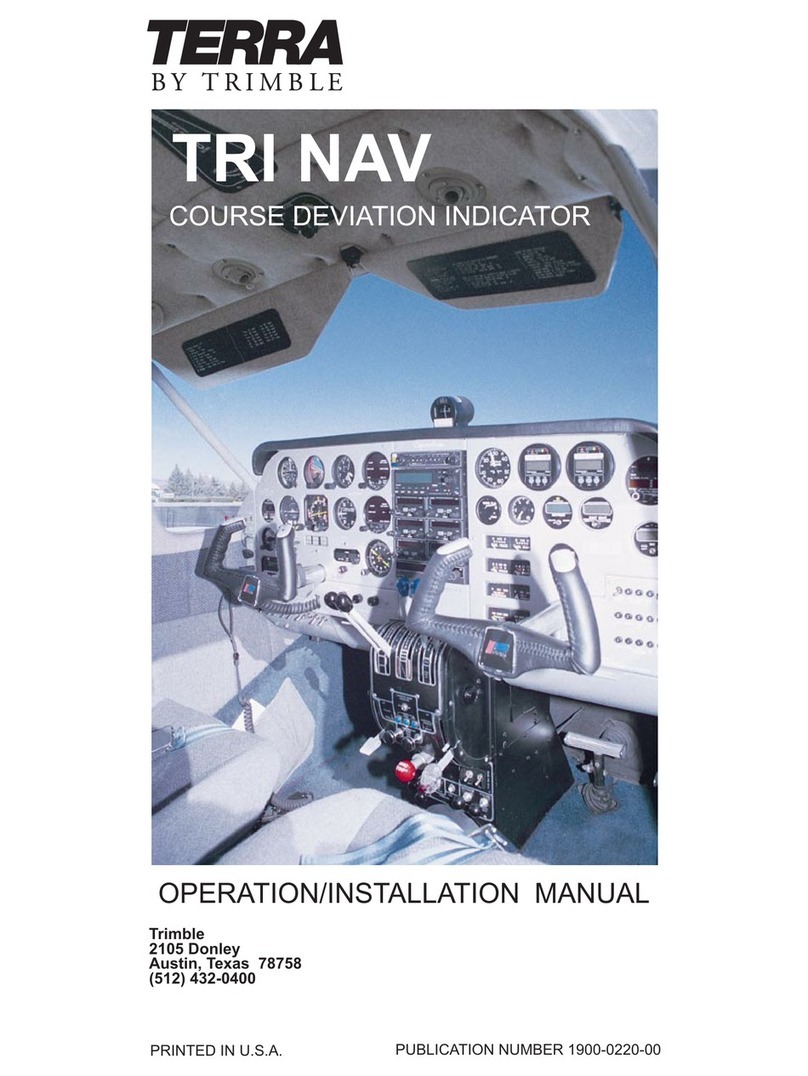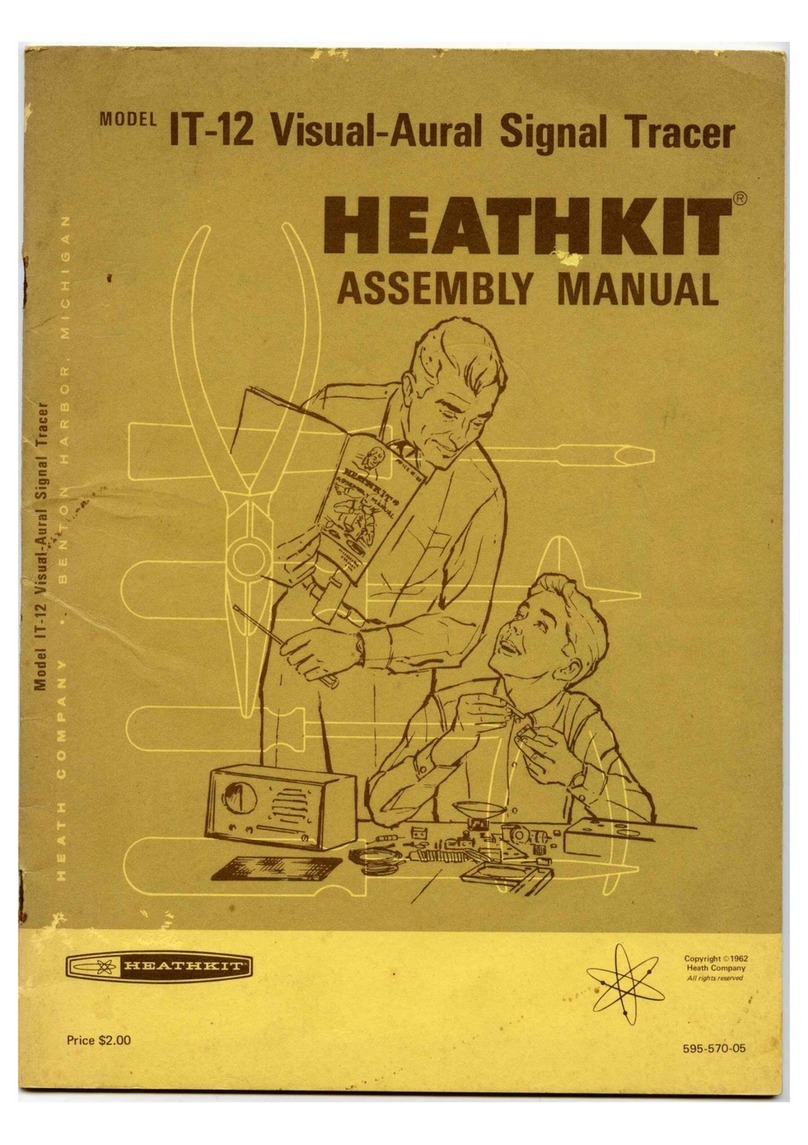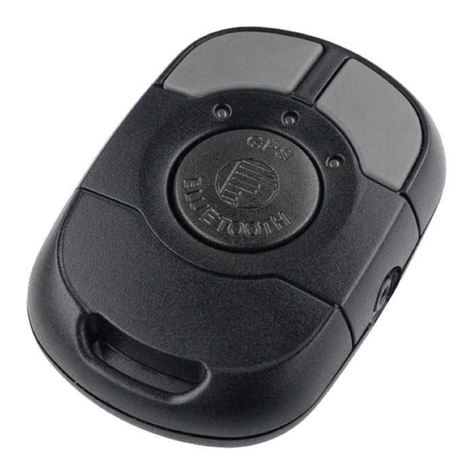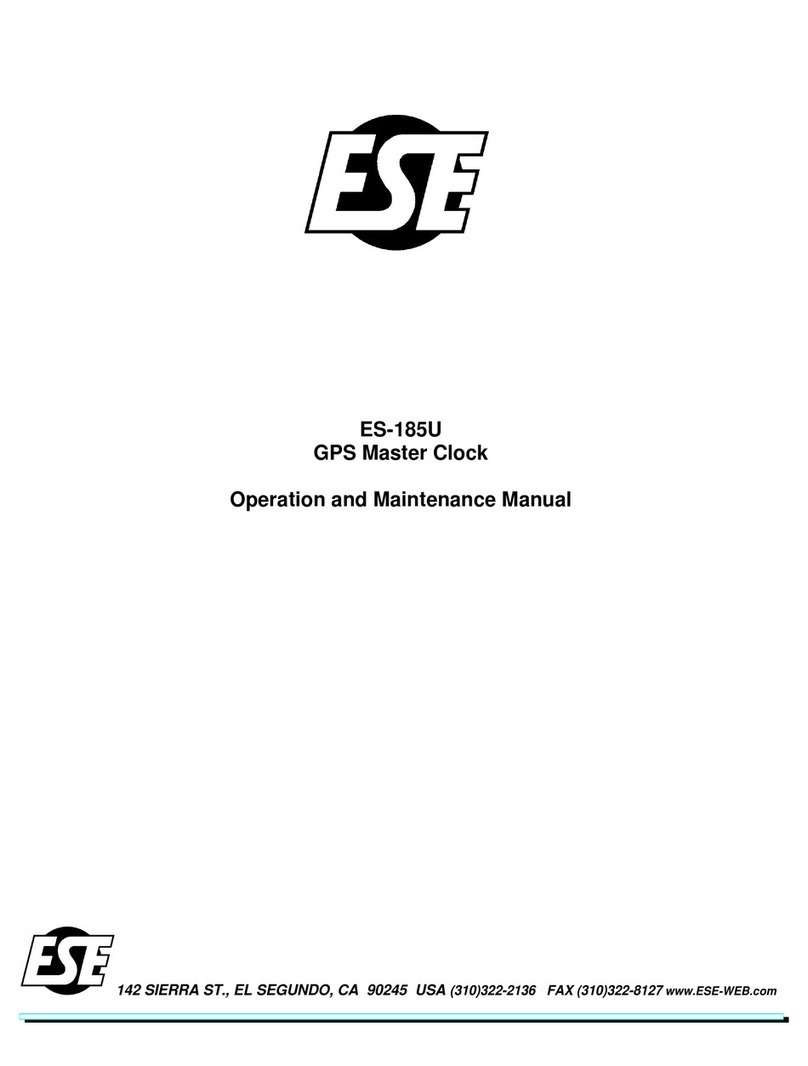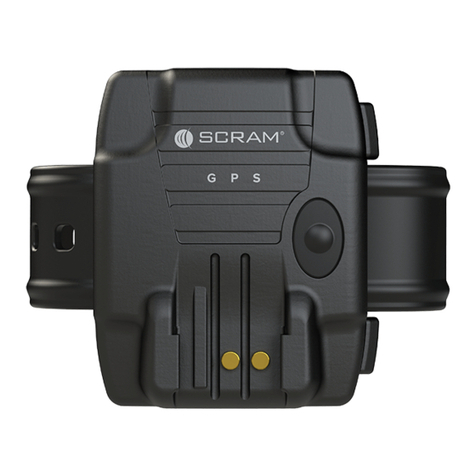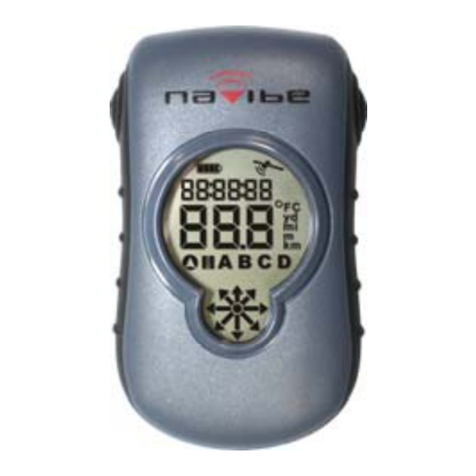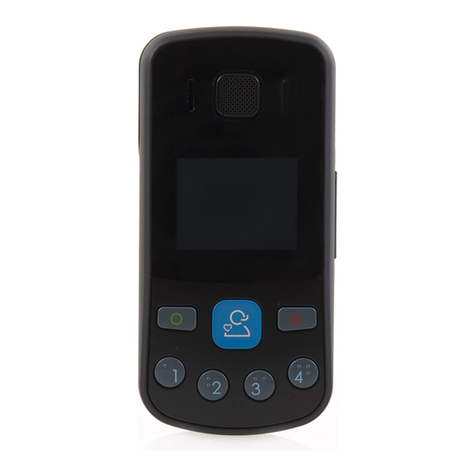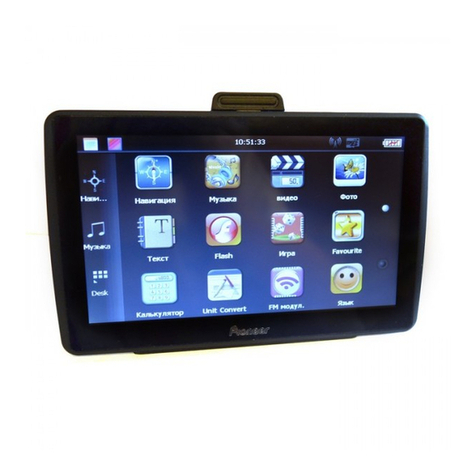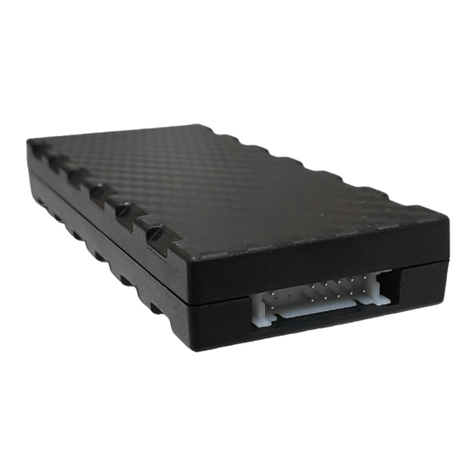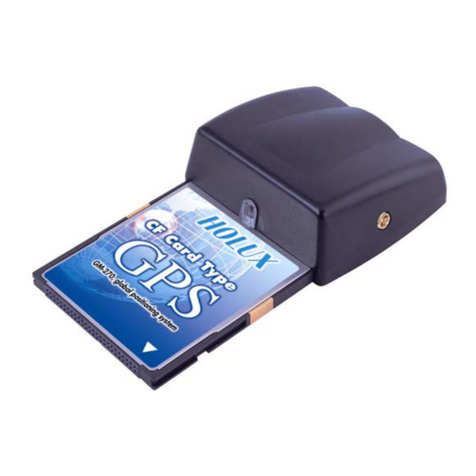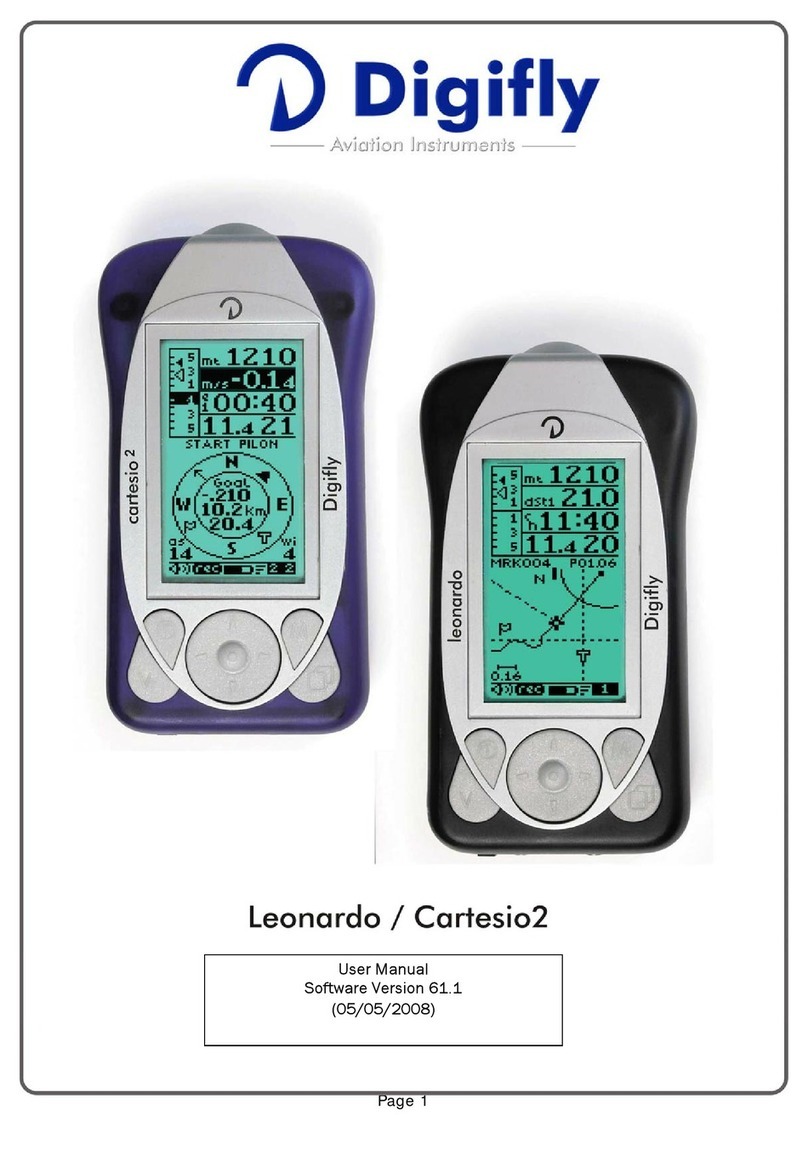Terra TN 200D User manual

OPERATION/INSTALLATION MANUAL
Trimble
2105 Donley
Austin, Texas 78758
(512) 432-0400
PUBLICATION NUMBER 1910-0007-01
PRINTED IN U.S.A.
TN 200D
NAVIGATIONAL RECEIVER

OPERATION/INSTALLATION MANUAL
Trimble
2105 Donley
Austin, Texas 78758
(512) 432-0400
AUGUST 19, 1996
PUBLICATION NUMBER 1910-0007-01
REVISION H
PRINTED IN U.S.A.
TN 200D
NAVIGATIONAL RECEIVER
T-1
Title Page

Revision H
August 19, 1996 TC-1
TN 200D NAVIGATIONAL RECEIVER
OPERATION/INSTALLATION MANUAL
TABLE OF CONTENTS
SECTION I .................................................................................................................................. 1
1. INTRODUCTION............................................................................................. 1
1.1 SCOPE ................................................................................................. 1
1.2 DESCRIPTION .................................................................................... 1
1.3 SPECIFICATIONS .............................................................................. 2
1.4 EQUIPMENT SUPPLIED ................................................................... 3
1.5 ADDITIONAL EQUIPMENT REQUIRED ........................................ 4
1.6 LICENSE REQUIREMENTS.............................................................. 4
SECTION II................................................................................................................................. 5
2. INSTALLATION .............................................................................................. 5
2.1 GENERAL ........................................................................................... 5
2.2 PREPARATION FOR USE ................................................................. 5
2.3 GENERAL INSTALLATION INSTRUCTIONS
FOR AVIONICS .................................................................................. 5
2.4 INSTALLATION................................................................................. 9
2.5 ANTENNA INSTALLATION .......................................................... 10
2.6 OPERATIONAL CHECKOUT ......................................................... 10
2.7 FINAL INSPECTION ........................................................................ 11
SECTION III ............................................................................................................................. 13
3. INSTALLATION DRAWINGS ..................................................................... 13
SECTION IV ............................................................................................................................. 27
4. OPERATION .................................................................................................. 27
(BELOW MOD 2 W/O GLIDESLOPE; BELOW MOD 3 W/ GLIDESLOPE)
4.1 SCOPE ............................................................................................... 27
4.2 OPERATION ..................................................................................... 27
4.3 FREQUENCY MODE ....................................................................... 27
4.4 IDENT OPERATION ........................................................................ 27
4.5 ILS AND DME CHANNELING OPERATION................................ 28
4.6 FREQUENCY TRANSFER .............................................................. 28
4.7 TO PLACE FREQUENCIES IN MEMORY..................................... 28
4.8 MEMORY/CHANNEL MODE ......................................................... 29

TC-2
Revision H
August 19, 1996
SECTION IV A ......................................................................................................................... 30
4. OPERATION .................................................................................................. 30
(MOD 3 AND ABOVE W/GLIDESLOPE; MOD 2 AND ABOVE W/O
GLIDESLOPE)
4.1A SCOPE ............................................................................................... 30
4.2A OPERATION ..................................................................................... 30
4.3A NAV TUNING KNOB OPERATION ...............................................30
4.4A IDENT OPERATION ........................................................................ 31
4.5A ILS AND DME CHANNELING OPERATION................................ 31
4.6A MEMORY OPERATION .................................................................. 31
4.7A TO PLACE FREQUENCIES IN MEMORY..................................... 31
4.8A DISPLAY BLANKING OPERATION.............................................. 32
SECTION V .............................................................................................................................. 35
5. LIMITED WARRANTY OF TERRA BY TRIMBLE PRODUCTS ............. 35
5.1 WARRANTY..................................................................................... 35
SECTION VI ............................................................................................................................. 37
6. INSTALLATION BULLETINS/NOTES ....................................................... 37
6.1 INSTALLATION BULLETINS ........................................................ 37
6.2 INSTALLATION NOTES ................................................................. 38

Revision H
August 19, 1996 1
SECTION I
1. INTRODUCTION
1.1 SCOPE
This manual provides installation and operation instructions for the Terra by Trimble TN
200D Navigational Receiver manufactured by Trimble of Austin, Texas.
1.2 DESCRIPTION
The Terra by Trimble TN 200D is a small, lightweight, all solid state navigational receiver
available with and without a glideslope receiver. The digital frequency synthesizer provides
200 channels with 50 KHz spacing from 108.00 to 117.95 MHz. The receiver provides VOR/
LOC information to navigational converters while the glideslope receiver completes the ILS
capability and supplies remote DME channeling.
The TN 200D features microprocessor controlled frequency synthesizers that employ phase
lock loop circuits to generate local oscillator frequencies. Other features include a user
programmable 10 location memory, active and standby frequencies displayed on a planar gas
discharge display, an Ident-voice switch to filter station Ident from receiver audio and a
rotary frequency selector.
The receiver can be mounted in three different configurations: in a single tray, in a double
tray or in a 3" ATI hole using the 3" adapter. With tray mounted units, all power and control
connections are made to a 15 pin “D” type connector installed in the rear of the mounting
tray. A standard BNC male chassis connector is supplied on the tray for antenna
connections. For the 3" option a locking, hooded, 15 pin “D” type connector and standard
BNC male connector are used respectively for power/control and antenna interfacing. The
TN 200D is secured by means of a positive locking cam, accessible through the front panel.
The 3" option is mounted with a minimum of 3 screws through the instrument panel.
Weighing only 1.14 lb. (.517 kg) without the glideslope option and 1.43 lb (.649 kg) with
glideslope, the TN 200D measures 11.450" long, 3.125" wide and 1.625" high (29.083 cm x
7.938 cm x 4.128 cm). Panel cutout is a mere 3.03" x 1.54" (7.70 cm x 3.91 cm) and the
overall length of the unit is only 12.80" (32.50 cm) including the mounting tray.
Pulling only 300 mA of current without the glideslope receiver and 600 mA with the
glideslope option, the TN 200D operates at 13.75 VDC. Operation at 27.5 VDC is possible
by utilizing an optional Terra by Trimble MLC 28-5 power converter P/N 0900-3219-12.
The TN 200D is designed to work with standard aircraft auxiliary audio amp systems as per
wiring diagram, or a high impedance headset.

Revision H
August 19, 19962
1.3 SPECIFICATIONS
The following are pertinent specifications for the FCC type accepted Terra by Trimble TN
200D Navigational Receiver.
1.3.1 MECHANICAL
Mounting: Panel mounted using mounting tray or 3" adapter as
provided
Overall Dimensions: 12.80" long, 3.125" wide, 1.625" high (32.50 cm long, 7.938
cm wide, 4.128 cm high)
Mounting Dimensions: 11.450" behind panel, 3.125' wide, 1.625" high (29.083 cm
behind panel, 7.938 cm wide, 4.128 cm high)
Panel Cutout: 3.03" x 1.54" (7.70cm x 3.91 cm)
Weight: 1.14 lbs (.52 kg) without G.S., 1.43 lbs (.649 kg) with G.S.
Connectors: Antenna input; BNC Interconnect cable; 15 pin “D” type
1.3.2 POWER REQUIREMENTS
The Terra by Trimble TN 200D navigational receiver requires 13.75 VDC input
+10%, -20% at 0.6 amps under maximum load conditions.
1.3.3 ENVIRONMENTALSPECIFICATIONS
Maximum Operating Conditions
Altitude: To 30,000 ft (9,150 meters)
Humidity: To 95% at 50oC (122oF)
Operating Temperature
Range: -20oC (-4oF) to +55oC (+131oF)
Vibration: 0.5 G from 5 to 500 Hz
1.3.4 ELECTRICALSPECIFICATIONS
VOR/LOC Receiver
Frequency Range: 108.00 to 117.95 MHz, 200 channels in 50 KHz steps
Sensitivity: 1.0uV for 6dB S+N/N ratio
Selectivity: Typically 6dB at +17 KHz and 50dB at +50 KHz
VOR/LOC Composite In LOC mode factory preset to .18Vrms for Terra by
Trimble TRI NAV/C Indicator
Audio Output: 100mW into a 500 ohm load

Revision J
December 16, 1996 3
1.3 SPECIFICATIONS (CONTINUED)
Glideslope Receiver
Frequency Range: 329.150 to 335.00 MHz, 40 channels in 150 KHz steps
Sensitivity: 20uV hard
DME Channeling: 2 x 5 code
External Glideslope Meter
Loading
Capabilities: Flag - 1K ohm load Up/down - 1K ohm load
Note:
For TN200D units with G.S. serial numbers below 1100 the internal load
may be removed to drive two 1 K loads (two TRI NAV’s).
1.4 EQUIPMENT SUPPLIED
The equipment supplied will depend upon the “system” you have ordered. The part numbers
and description listed below indicate the equipment supplied with each “system”.
0990-5300-00 TN 200D with G.S. Single System
1. 1ea Nav Receiver with G.S. Terra by Trimble TN 200D
P/N 1900-0350-00
2. 1ea Mounting Tray, Single
P/N 1900-0357-00
3. 1ea Installation Kit
TN 200D P/N 1901-2671-10
4. 1ea Operation/Installation Manual
P/N 1910-0007-01
5. 1ea Warranty Card
0990-5301-00 TN 200D without G.S. Single System
1. 1ea Nav Receiver without G.S. Terra by Trimble TN 200D
P/N 1900-0350-10
2. 1ea Mounting Tray, Single
P/N 1900-0357-10
3. 1ea Installation Kit
P/N 1901-2671-10
4. 1ea Operation/Installation Manual
TN 200D P/N 1910-0007-01
5. 1ea Warranty Card

Revision J
December 16, 19964
1.4 EQUIPMENT SUPPLIED
0990-5316-00 TN 200D with G.S. 3" System
1. 1ea Nav Receiver with G.S. Terra by Trimble TN 200D
P/N 1900-0350-00
2. 1ea Mod Kit TN 200D with G.S.
P/N 1901-5312-20
3. 1ea Operation/Installation Manual
TN 200D P/N 1910-0007-01
4. 1ea Warranty Card
0990-5317-00 TN 200D without G.S. 3" System
1. 1ea Nav Receiver without G.S. Terra by Trimble TN 200D
P/N 1900-0350-10
2. 1ea Mod Kit TN 200D without G.S.
P/N 1901-5312-30
3. 1ea Operation/Installation Manual
TN 200D P/N 1910-0007-01
4. 1ea Warranty Card
1.4.1 OPTIONAL EQUIPMENT
Voltage converter 27.50 to 13.75 V Model MLC 28-5, Terra by Trimble P/N 0900-
3219-12.
1.5 ADDITIONAL EQUIPMENT REQUIRED
1. Sufficient RG 58A/U 50 ohm coaxial antenna cable to reach from the receiver to the
antenna. BNC coaxial fittings as required for the particular installation.
2. MIL 22759 or equivalent wire sufficient to make the harness.
3. Circuit breaker rated at 3 amps.
4. 50 ohm navigational antenna rated at top speed of aircraft.
1.6 LICENSE REQUIREMENTS
Not applicable

Revision H
August 19, 1996 5
SECTION II
2. INSTALLATION
2.1 GENERAL
This section contains all necessary installation instructions and checkout procedures for the
Terra by Trimble TN 200D Navigational Receiver.
2.2 PREPARATION FOR USE
Every precaution has been taken to protect the TN 200D during shipment. Upon receipt of
theequipment,performthefollowinginspections:
1. Remove the unit from the shipping container and visually inspect for damage.
2. Check controls and switches to determine if they may have been damaged.
3. Make sure that all hardware and connectors listed in Section I, under “Equipment
Supplied”, are present.
If the unit is damaged, a claim must be filed with the carrier. The carrier assumes title of the
unit when it accepts it for shipment. Do not return it to Trimble or its representatives.
It is suggested that the package be retained for inspection by the carrier in the case of
damage or for future use should it be necessary to ship the unit for service or to transfer it to
anotherlocation.
2.3 GENERAL INSTALLATION INSTRUCTIONS FOR AVIONICS
The following paragraphs contain pertinent hints, advice, and guidance intended for use by
installers of avionics equipment. These have been drafted to address common problems
encountered during the installation process. Specific questions may be addressed to Trimble
for technical assistance by calling 1-800-487-4662 and requesting Technical Assistance.
2.3.1 COAXIAL CABLES AND CONNECTORS
Improper installation of coaxial cables and connectors create many of the problems
encountered during avionics installations. Refer to Figure3-1 for guidance of typical
BNC connector assembly. Refer to Figure 3-2 for instructions about connecting coax
cable to the BNC connector(s) mounted at the rear of Terra by Trimble mounting
trays. Problems to avoid include twisted, chafed, or pinched cables, sharp bends in
cables, open or shorted center conductors or shield braid, and improper grounding of
shields. Also, proper termination of antenna coaxial cables at the antenna should be
carefully checked. After installing connectors, pull firmly to ensure good mechanical
bonding (particularly if you use crimp-on connectors) and use your ohmmeter to
insure good electrical connection with no shorting. Be sure that coax lengths and
types follow the avionics manufacturer’s recommendations.

6
Revision H
August 19, 1996
2.3.2 ANTENNAS
The three cardinal points for antenna installation are location, mounting and electrical
characteristics.
AntennaLocation:
Provide an area where shadowing of the antenna will not occur (eg. blocking of the
signal by other parts of the aircraft). Remember that at VHF frequencies and above,
direct line of sight signals are required from ground stations to the antenna and for
maximum effective range. Consider that close proximity of an antenna to other
antennas or noise sources may create interference problems. Read carefully and
follow closely the recommendations of the antenna manufacturer about antenna
location.
AntennaMounting:
Proper attachment of any antenna to the aircraft surface is of primary importance.
Carefully clean all paint and corrosion off the mounting surface and apply an anti-
corrosion treatment. Do the same to the inside surface if a backing or nut plate is to
be used. Mount the antenna securely per the antenna manufacturer’s
recommendations and check carefully to insure good electrical bonding. Do not
mount any antenna to doors, hatches, inspection plates or other moveable surfaces
because proper bonding to the aircraft surface cannot be accomplished. After proper
mounting and bonding is achieved, a bead of high quality RTV around the junction of
the antenna base and the aircraft surface will prevent water seepage and corrosion
from forming between the antenna base and aircraft surface.
Antenna Electrical Characteristics:
Use the antenna supplied with the avionics equipment, or if not supplied, the
antenna(s) recommended by the avionics manufacturer. If no specific antenna is
recommended, choose an antenna which provides good service for the frequency
range and the service conditions of the aircraft (eg. speed, altitude, etc.). If a signal
splitter is to be used, compare the specifications carefully to the application. Many
installation problems are encountered with improper application of signal splitters! If
in doubt, test the power and frequency characteristics of the splitter on the bench to
be sure.
Simple antenna problems such as shorting or open circuit problems can be determined
by use of an ohmmeter, although certain types of antennas may require use of ramp
test equipment to check radiation. But, by far, the most common antenna problems
are diagnosed to be coax or connectors, antenna bonding, or signal splitters. Never
allow an aircraft antenna to be painted.

Revision H
August 19, 1996 7
2.3.3 WIRING AND HARNESSING
Construct the installation wiring harness carefully from the avionics manufacturer’s
wiring diagram. Be extremely careful to note recommended wire sizes, the need for
shielded wiring (if any), and decide upon any optional wiring to be included. Measure
carefully and plan the harness layout to avoid interference of the cable harness with
existingavionics,instrumentsorcontrols.
Remove the connector plates from the rear of the trays. Connect all wires to the
proper pin of each connector, checking as you go to insure that no loose strands cause
shorting to adjacent pins or to ground surfaces. We recommend tubing be placed
over each soldered pin connection to prevent wire strands from touching adjacent
connections. Be particularly careful with the shield braids of shielded wires. Do not
expose any more of the conductor than is absolutely necessary and keep the braid
connection as short as possible. Remember that on shielded wires only one ground
point is recommended. Follow manufacturer’s recommendation about where the
ground point should be located. After completing all connections, check wiring
with an ohmmeter again to ascertain that all connections are as desired and
that no undesired shorting to ground or other pins has occurred. Visually
double check to see that braids on shields are not creating shorting that no insulator
meltinghas occurredduring solderingand pullfirmly onall connectionsto insuregood
mechanicalbond.
Install the harness and connectors/connector plates in the aircraft with very loose
dress only.
Solder all connections to power and ground and install panel components/controls and
safety devices (eg. fuses or breakers). It is desirable at this point to insert all
equipment in trays and perform preliminary check-out. Following a satisfactory
check-out,and withall equipment in the properly installed location,complete thefinal
dressing and routing of the harness and secure in place.
Note:
It is extremely important that units should be installed in trays while final dress
and bundling of the harness is accomplished to assure proper alignment of
connectors between tray and unit. Failure to do this may cause problems
when unit is initially inserted into tray due to misalignment of connectors!
The final step is to perform a complete check of all avionics operations and insure that
free movement of all cockpit controls is available.
2.3.4 NOISE AND INTERFERENCE
The typical airframe is a small and imperfect platform for providing all of the antenna
ground planes and power sources and inter-wiring required for avionics operations,
particularly for a low noise and interference free expectation. This subject is far too
broad and complex to address in detail in a few paragraphs. However, an approach
to categorizing and defining the problem can be outlined.

8
Revision H
August 19, 1996
2.3.3 NOISE AND INTERFERENCE (CONTINUED)
Noise and/or interference is usually heard in the audio systems, although it may also
be detected as an interference to indicator operation. Unless a strong suspicion of the
exact source is suspected, it is best to begin a process of elimination, in the following
order:
1. Power Source: Check for low voltage when the avionics load is
applied. A high resistance battery cell in the A/C can cause
numerous problems. View the avionics power line at the avionics
master and at the affected unit for noise on the power line. If
present, try to categorize the frequency (eg. alternator whine, which
may be caused by one or more bad alternator diodes, or if
interference is present only when a communication unit is
transmitting, etc.). If the noise is present or worse at the affected
unit than at the avionics master, investigate the harness for noise
coupling between wires. If necessary, disconnect the affected unit
power from the aircraft power source and connect to an external
power supply or battery.
2. Power Ground: View the power ground line at the avionics master
and the affected unit. If noise is discerned at the master source,
ground strapping may be corroded or partially broken. If only at unit,
a larger wire size or wire re-routing may be required.
3. Interference: Both noise and interference may be either conducted
or radiated, and in some cases electromagnetically coupled between
units. If it is determined that the noise or interference is eliminated
whenever another avionics unit is not transmitting, first investigate the
radiated alternative. Insure complete and proper bonding of antennas
to the aircraft surface, and check the coaxial cable and all shield
connections and connectors. Review the manufacturer’s
recommendations for antenna separations. Be aware that antenna
radiation directly to conductors at the rear of mounting trays or units
may occur if shields are stripped too far back from the connector or
are improperly grounded. Disconnecting the interfering antenna and
substituting an external dummy load may assist diagnosis. Conducted
interference usually occurs through paths which are shared by the
avionics equipment such as power lines, ground points, audio
equipment, or induced interference between adjacent wires or
harnesses. Review the manufacturer’s recommendations for
shielded wiring and ground points, and for separation of specific
wires. Measure ground points for a small but perceptible resistance
to true ground and view power lines with an oscilloscope, turning
each unit on and off to detect changes. Recheck common or
adjacent connections to jacks, plugs, or shared equipment such as
power converters, breakers, or audio panels.
4. Compromise: In some cases noise or interference may be subdued
but not eliminated. With the inefficient and imperfect platform
provided by the aircraft for antennas and power source, etc, complete

Revision H
August 19, 1996 9
2.3.3 WIRING AND HARNESSING (CONTINUED)
elimination of the problem may be very expensive or impossible (eg.
if there is simply not enough space to provide ground plane or
antenna separation as recommended). Or, the aircraft strobe noise is
audible but not objectionable, etc. These problems should be
discussed early and thoroughly with the customer.
2.3.5 SUMMARY
The paragraphs above are not intended to be highly technical, completely thorough, or
extensive, but serve as a reminder for certain precautionary or follow-up procedures
for general avionics installations. Trimble is prepared to assist at any point with
additionalinformation,hints,orliterature. Simplycall1-800-487-4662andaskfor
technical assistance.
2.4 INSTALLATION
Installation of any equipment in an aircraft requires that the work be performed by a
Certificated Radio Repair Station with appropriate ratings. The installing agency must
complete an FAA Form 337 and compute a new weight and balance for the aircraft for
insertion in the Aircraft Flight Manual. Unless the mechanic is the designated inspector for a
Certificated Radio Repair Station or holds an Inspection Authorization, the work is subject to
inspection and approval of an FAA inspector or the holder of an Inspection Authorization.
The following items and suggestions should be considered prior to installation of your Terra by
Trimble TN 200D Navigational Receiver.
1. Discuss the location of this receiver with your customer, preferably in a position that
provides ease of operation.
2. Avoid installing the TN 200D near heat sources. If unavoidable, insure additional
coolingisprovided.
3. Insure that adequate clearance exists behind the panel for sleeve, connectors, and
additional cooling if required. A minimum of 14.00" (35.56 cm) is recommended.
4. Refer to Terra by Trimble TN 200D Outline Drawings for panel cut-out details and
mounting dimensions as well as pertinent notes.
5. Install the sleeve assembly in the instrument panel. Insure compliance with standards
set forth in the FAA Aircraft Inspection and Repair Document AC 43.13-2A.
Note:
Insure that the sleeve is installed with the large opening toward the top.
6. The 15 pin “D” connector assembly supplied with the Terra by Trimble TN 200D
must be wired correctly to the aircraft avionics systems or severe damage may result
to the Terra by Trimble TN 200D or other systems. The interconnecting wiring for
the 15 pin “D” connector is shown in Figure 3-6 (without glideslope) and Figure 3-7
(with glideslope). Comply with standards set forth in FAA Aircraft Inspection and
Repair Document AC 43.13-1A Section 7 and other pertinent FAR’s as required.
Insure MIL-SPEC wire is utilized for all interconnects.

10
Revision H
August 19, 1996
2.4 INSTALLATION (CONTINUED)
CAUTION: The operating voltage of this Terra by Trimble TN 200D is
13.75 V nominal for direct connection to an aircraft 12-14 volt electrical
system. If the aircraft electrical system supply is 24-28 volt, it will be
necessary to employ a converter to reduce the 28 volts to 13.75 volts for the
Terra by Trimble TN 200D. Terra by Trimble can supply an optional
converter specifically designed for this purpose. It is Terra by Trimble P/N
0900-3219-12,ModelMLC28-5.
7. Install the TN 200D in the mounting tray assembly. Use caution as the rear
connectors mate. After the float mounts are positioned correctly (a little twisting at
the front panel may be necessary), the unit will fully engage the connectors with light
to medium pressure on the front panel.
CAUTION: DO NOT PUSH UNIT INTO TRAY WITH THUMBS
ON LENS AS DISPLAY DAMAGE MAY RESULT!
Insert a 7/64" Allen wrench in the front panel hole and engage the locking screw.
Turn clockwise until the cam has engaged itself in the tray and is moderately
tightened. Use caution to prevent stripping the threads on the locking cam or screw.
To remove the unit from the mounting tray, insert the 7/64" Allen wrench in the
locking screw and turn counterclockwise. The cam will move the unit outward about
1/4" and disengage the connectors. The unit may now be pulled out of the mounting
tray by hand.
8. The connector bracket is mounted from the front side of the sleeve with two Phillips
head screws and lock washers. As viewed from the front of the unit, pin 1 of the
connector is top right and pin 15 is bottom left.
2.5 ANTENNA INSTALLATION
A 50 ohm horizontally polarized navigational antenna is recommended. Insure tested speed of
the antenna matches top speed of the aircraft. Connect the antenna to the Terra by Trimble
TN 200D using standard 50 ohm coaxial cable such as RG 58A/U. Terminate the cable with
BNC coaxial connectors as required. Ohm out the coax to insure no shorts are present.
Select a location providing a clear line of sight and symmetrical to the centerline of the
aircraft. Insure proper bonding of the antenna to the aircraft.
2.6 OPERATIONAL CHECKOUT
1. Rotate OFF/ON/VOLUME/IDENT (left side) knob clockwise past the detent to turn
receiver on. This will also supply power to the indicator if it is connected to switched
power out.
2. Rotate TUNE (right side) knob to obtain the desired frequency in the right hand
window. Verify that the faster the knob is rotated the more the frequency changes
with each detent.
3. Press the “<—>” (TRANSFER) button and verify that the two frequencies “swap”
sides in the display.
4. Rotate the ON/OFF/VOLUME/IDENT knob clockwise and verify white noise on the
audio out. If a VOR station is within range, verify that whenever the left knob is
depressed the ident is eliminated from the audio output and with the knob pulled out all
the received audio is applied to the audio output.

Revision H
August 19, 1996 11
2.7 FINAL INSPECTION
1. Insure that all wiring is properly routed and secure. Dress harnessing neatly and
secure in place with cable ties. Check connector integrity and locking devices.
Insure locking devices are functioning properly and are secured. Verify cabling is not
“clotheslined” and provisions have been made for service loops. Pull yoke to its
maximum travel. While slowly returning yoke to its normal position, rotate yoke left
and right to insure all cabling is routed and tied up properly. Cycle rudder pedals and
verify that they are free and cables are unobstructed. Install gust locks, perform
complete checkout of all avionics including dimmers. Secure aircraft power and all
master switches.
2. Have installation inspected by someone authorized under Federal Aviation Regulation
Part 65.
3. Add the Terra by Trimble TN 200D to the aircraft equipment list, including serial
number. Complete FAA Form 337 if required, and make required airframe logbook
entries. A weight and balance change may be required, depending on the type of
aircraft.
4. Complete warranty card and return to Trimble.

12
Revision H
August 19, 1996
THIS PAGE INTENTIONALLY LEFT BLANK

Revision H
August 19, 1996 13
SECTION III
3. INSTALLATION DRAWINGS
Figure 3-1
Coax Connector Instructions

14
Revision H
August 19, 1996
THIS PAGE INTENTIONALLY LEFT BLANK

Revision H
August 19, 1996 15
Figure 3-2
Coax Connector Instructions

16
Revision H
August 19, 1996
THIS PAGE INTENTIONALLY LEFT BLANK
Table of contents
Other Terra GPS manuals
